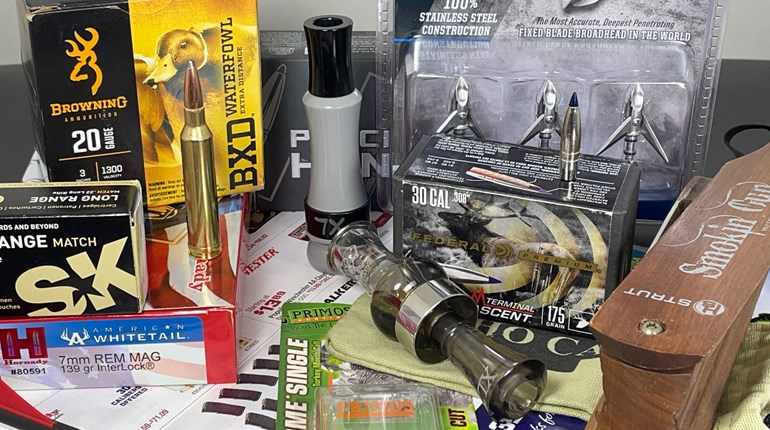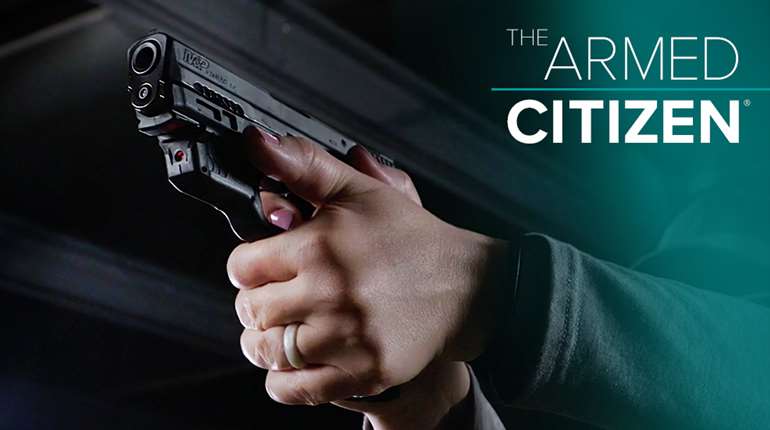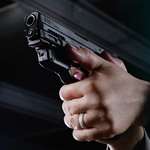
The process of making a rifle/scope combo hit where the bullseye of the scope is aiming is called sighting the gun in. It’s not a difficult process, but if you don’t know how to do it properly, you can waste a lot of time and ammo fumbling your way through it.
Once your scope is mounted, head to the range. Start at 50 yards with a simple paper target (bigger is better) with a clear aiming point. You will need a steady rest for the front and the rear of the gun, so it can be tweaked without your having to hold it. A Caldwell Lead Sled is very popular for this, as it holds the gun firmly and absorbs a lot of the recoil when you’re shooting, but traditional sandbags, a bipod or a combination of the two will also work very well.
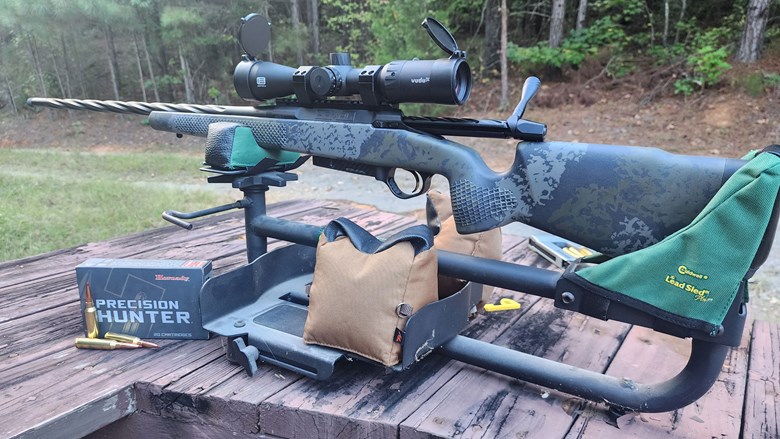
Your first task is to get the rifle hitting the paper, and a bore sight is helpful for this. A bore sight is a small device that you insert into the barrel of your unloaded rifle, and it projects a laser out from the muzzle (bore). Arrange the gun so that the laser is pointing at the bullseye of the target, and then, without moving the gun, get behind it as if to shoot and use the scope’s dials to move the reticle so that it is pointing at the same spot as the laser. Now you’re bore-sighted.
If you don’t have a bore sight, you can accomplish the same thing, albeit a little less precisely, by removing the bolt from your rifle and peering directly down the barrel from the action end. Move the gun until you can look down through the barrel and see the bullseye. Then, without moving the gun, adjust the scope so that its reticle is on the bullseye. You’re close to bore-sighted.
Either of these methods should get you on paper at 50 yards, but make no mistake: You are not done. You still have to shoot the gun to dial things in precisely. There are two ways to do this.
The Two-Shot Method
As a bit of a numbers nerd, I don’t care for this method, but it works for most people. Fire one good shot at 50 yards. Then, line the gun up so the crosshairs intersect the bullseye again. Keep the gun perfectly steady, and while looking through the scope, use your turrets to adjust the crosshairs until they are lined up with the hole from your first shot.
Now, move the gun so the crosshairs are pointed at the bullseye and fire another shot. It should be right on target. If it’s not, repeat the adjustments until you’re hitting dead-center. Then move out to 100 yards and beyond and shoot to verify your point of impact at different ranges, adjusting your zero to be dead-on or 1 inch high at 100 yards or whatever your preference is.
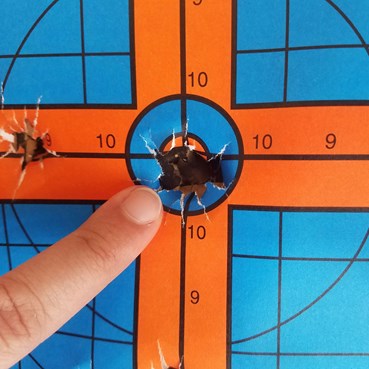
The Measure-and-Click Method
This is my preferred method, but I honestly have no good reason for liking it. It takes longer and there’s math involved, but it’s what I’m used to, so it’s what I do.
First, fire one shot, or better yet, three shots at the bullseye from 50 yards. Then unload the firearm and walk downrange. If you shot three times, locate the center of the “group” of hits. Measure how far off the bullseye your shot or the center of your group is. Let’s say, as an example, your shots are 2 inches high and 1 inch to the left.
Once you know how far you’re off, it’s time to dial your scope’s elevation and windage turrets. Always dial in the direction you want the bullet to go—if you’re hitting high and you want the bullet to hit farther down, dial down. If you want the bullet to hit farther to the right, dial right. All of my scopes are in MOA, so that’s how I’ll explain this, but if your scope uses mils, the idea is the same—only the numbers are different.
Most MOA scopes move ¼ MOA with each click (if yours is different, it will say so, and you’ll have to adjust these example numbers accordingly). One MOA (minute of angle) is 1 inch at 100 yards and 1/2 inch at 50 yards. This means that at 100 yards, each click will move the crosshairs ¼ inch, but at half that distance (50 yards), each click will move the crosshairs just 1/8 inch. If you need to come 2 inches down, you will dial 16 clicks down on your scope’s elevation turret. In our example, you’d also need to dial eight clicks (1 inch at 50 yards) right.
Shoot again, at least once but more if you aren’t sure you made a clean shot. You should be on or darn close to the bullseye. If you’re not, check your math again and make further adjustments until you are.
Then move out to 100 yards and shoot a three-shot group. Adjust your zero using the same method, remembering that one click is ¼ inch at this distance. Set your point of impact to be dead-on the bullseye or one inch high at 100 yards or whatever you prefer.
If I am close—within three inches or so in any direction—at 50 yards, I’ll often go straight to 100 yards and shoot, then start making scope adjustments, just because the math is easier. If you start at 50 and you’re not hitting paper, move to 25 yards until you can at least get on target.
Once your rifle is hitting where you want it at 100 yards, you’re sighted-in and ready to hunt. You can use a ballistics app to see how far your bullet will drop at distances beyond that, but if you are planning to hunt with this rifle, it’s imperative that you actually shoot the gun at the distances you plan to hunt at to verify that point-of-impact really is what the app says it’s supposed to be. This is part of learning your rifle well, and the more familiar you are with your rifle/scope combo, the better shooter you will become.
One more word of warning: If you change ammo—certainly if you change brands, but also if you change projectile or type or ammo or weight even within the same brand—you need to sight-in all over again. You can almost certainly do this starting directly at 100 yards, because the difference isn’t likely to be off-the-paper huge, but different ammo shoots differently, and the gun needs to be re-zeroed every time you swap to a different type of ammunition.













